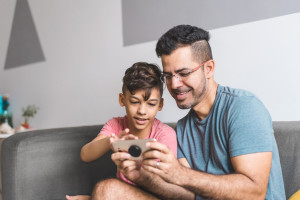When kids become content: the risks of sharenting

Amanda Lee
Senior Program Manager, Tech for Good™ & TELUS Wise®

Scroll through your social media feeds on any given day, and no doubt you will see pictures of people’s kids. First day of school, summer vacation, birthday parties, dance recitals and family gatherings - the list goes on.
Sharenting, a phrase coined by the Wall Street Journal, is defined as, “the action or practice of sharing news, images or videos of one’s children on social media.” In most cases, sharenting is a fun, interactive way to update family and friends. In other cases, especially with the growing popularity of influencer culture and the creator economy, kids are being monetized and using them as content can be a way to big bucks.
In either case, sharenting creates risks around child privacy, informed consent, online safety and cyberbullying. In this article, we explore some stats and stories that may surprise (or shock) you and what parents can do to “share” more responsibly.
Sharenting in numbers
Security.org surveyed 1,000 parents and teens in the U.S. about their sharenting habits and perceptions. Here is what the survey revealed:
- More than 75% of parents had “sharented”
- More than 80% of parents use kids’ real names in their posts
- Less than 25% get their kids’ permission before posting
- 29% never ask permission at all
- Close to 25% have public settings on their social media apps (meaning anyone can see what they post)
- 80% have friends/followers on social media they haven’t met in real life
While those may seem like astounding stats, many parents aren’t aware of the potential risks that a seemingly innocent post can create.
Influencers take hold
While many parents are posting kid content exclusively for family and friends, a whole industry, known as Influencer Marketing, has emerged. According to the Influencer Marketing Benchmark Report, the influencer marketing industry will be valued at $24 billion by the end of 2024.
Brands use influencer marketing to build community and reach audiences on a personal level. But some parents have seen the dollar signs and taken things way too far. For instance, The New York Times published an article about “girl influencers” on Instagram, where moms are running their daughter’s accounts. Take Elissa, for example. She’s been managing her daughter’s Instagram account since her daughter was 11 (according to Meta’s rules, kids can’t have their own accounts until they are 13). Elissa’s daughter models evening dresses, high-end workout gear and dance leotards. The account has gained popularity, with more than 100,000 followers, mostly men. Elissa has even jumped on Instagram’s subscription feature, charging $9.99 a month for exclusive photos you won’t see on the main feed.
Sounding the alarm bells
Kids as content, whether for fun or commerce, is also gaining a very vocal “unfollowing.” CBC interviewed several experts about the risks associated with sharenting. They cited privacy and exploitation as key concerns.
Sarah Adams (@mom.uncharted) has become a passionate advocate against sharenting and kidfluencing. She recently launched kidsarenotcontent.com dedicated to exploring the impact of sharenting and advocating for better online privacy protections for kids.
Sarah is a mother of two kids under five and she doesn’t sharent. In her view, “the state of parental oversharing has reached worrisome new heights. Children have a right to privacy, informed consent and online safety.” She also calls on platforms, governments and brands to step up to protect kids from growing up in the public eye without their knowledge or informed consent.
Posting responsibly
According to Kids Are Not Content, on average, kids have 1,300 photos of themselves circulating on social media platforms before age 13 (when they are legally allowed to have their own accounts). It’s normal to want to share your family’s experiences with loved ones online, but it's essential to share responsibly and respect your child’s privacy, right to consent and digital future.
- Ask your child's permission: ensure they are comfortable with their lives being posted online
- Think critically about content: reflect on whether you’d be comfortable if a stranger saw your post, how your child’s peers might react and what the impact could be 10 years from now
- Avoid personally identifiable information: ensure no identifiable information like school logos, house numbers or mail with your address on it are in photos and videos
- Model good digital citizenship: show your kids how to act online by setting a positive example
Like anything online, there are rewards and risks. To keep things positive, it’s important to be mindful and vigilant. Think about what you post. And if your kids are content at any time, involve them in the conversations about what you’re posting, ask how they feel about it and make it clear how it contributes to their digital footprint. With your help and example, they can learn how to protect their own privacy, reputation and safety online.
To learn more about supporting youth in our digital world, participate in an online TELUS Wise workshop for parents.
There is more to explore

Social media
Do you know what your kids are watching on YouTube?
Learn how to keep your kids safe on YouTube with built-in parental controls, supervised experiences and practical conversation tips.
Read article
Social media
Kids on social media: 3 benefits, 3 risks
Learn how to create a safe online environment by being aware of both the advantages and challenges of social media.
Read article